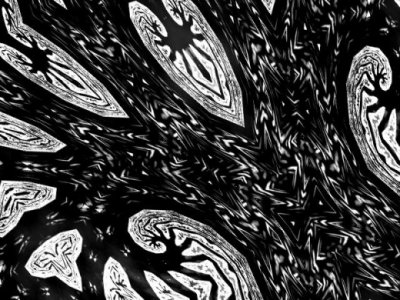

2006, Netherlands, video, b/w, sound, 3 min.
"The tight synchronization of video and audio is the dominant source of tension in this piece - the visual activity is mapped explicitly pixel-per-pixel to the audio track, resulting in an intense multi- sensorial experience for the viewer. It was inspired by the experimental video works of computer graphics pioneers such as Lillian Schwartz and John Whitney. The use of fractal-generated source material gives this work an organic quality, while its compact form provides a sense of immediacy and contiguity.
Black Noise White Silence was conceived and created as a pure representation of music as digital data. The digital medium has rapidly dominated the way in which we not only create music, but especially in how music is consumed. Because of this, digital representations of sound are now nearly always the stage between the composer and the realization of a composition, as well as the step between the realized composition and its consumption by an audience.
However most people rarely stop to think about this new way of representing sounds and images and the implications of the digital medium. One obvious benefit is the ease of distribution of digital works: Black Noise White Silence can be viewed in a multitude of contexts, from film theater to television to iPodVideo, without losing its meaning or intention. In a sense, the medium is the work itself, and the medium is in this case flexible enough to allow infinite transpositions of the work to many different contexts.
Another implication of working in the digital domain is the extent to which computing power can be harnessed to extend creative possibilities. Black Noise White Silence was generated through the use of algorithms conceived by the composer and which were performed by a machine in real-time. The composer guided and influenced the algorithms during the creative process; his role lay in between the deterministic and spontaneous (or intuitive?) decision making processes."
